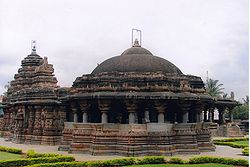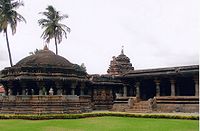
Ishvara Temple (Arasikere)
Encyclopedia

Arsikere
Arsikere is a town in the Hassan district in the state of Karnataka, India. Arasikere is a major railway junction on the South Western Railway...
, Hassan district
Hassan district
Hassan is a district in Karnataka state, India. The district headquarters are Hassan.Hassan district was the seat of the Hoysala Empire which at its peak ruled large parts of south India from Belur as its early capital and Halebidu as its later capital during the period 1000 - 1334 CE...
of Karnataka
Karnataka
Karnataka , the land of the Kannadigas, is a state in South West India. It was created on 1 November 1956, with the passing of the States Reorganisation Act and this day is annually celebrated as Karnataka Rajyotsava...
state, India
India
India , officially the Republic of India , is a country in South Asia. It is the seventh-largest country by geographical area, the second-most populous country with over 1.2 billion people, and the most populous democracy in the world...
, dates to c. 1220 CE rule of Hoysala Empire
Hoysala Empire
The Hoysala Empire was a prominent South Indian Kannadiga empire that ruled most of the modern day state of Karnataka between the 10th and the 14th centuries. The capital of the Hoysalas was initially located at Belur but was later moved to Halebidu....
. Arasikere (lit "Queens tank"; 'Arasi' means "queen" or "princess" and 'kere' means "tank" in the Kannada language
Kannada language
Kannada or , is a language spoken in India predominantly in the state of Karnataka. Kannada, whose native speakers are called Kannadigas and number roughly 50 million, is one of the 30 most spoken languages in the world...
) is located 60 km north the historic city of Mysore and 41 km north of Hassan city. The temple, which is dedicated to Hindu
Hinduism
Hinduism is the predominant and indigenous religious tradition of the Indian Subcontinent. Hinduism is known to its followers as , amongst many other expressions...
God Shiva
Shiva
Shiva is a major Hindu deity, and is the destroyer god or transformer among the Trimurti, the Hindu Trinity of the primary aspects of the divine. God Shiva is a yogi who has notice of everything that happens in the world and is the main aspect of life. Yet one with great power lives a life of a...
, though modest in size and figure sculpture, is considered the most complex in architecture among surviving Hoysala monuments
Hoysala architecture
Hoysala architecture is the building style developed under the rule of the Hoysala Empire between the 11th and 14th centuries, in the region known today as Karnataka, a state of India. Hoysala influence was at its peak in the 13th century, when it dominated the Southern Deccan Plateau region...
because of its ground plan: a 16-pointed star shaped mantapa (hall), in addition to an asymmetrical star shaped shrine, whose star points are of three different types.
Temple plan

Soapstone
Soapstone is a metamorphic rock, a talc-schist. It is largely composed of the mineral talc and is thus rich in magnesium. It is produced by dynamothermal metamorphism and metasomatism, which occurs in the areas where tectonic plates are subducted, changing rocks by heat and pressure, with influx...
as basic building material and is a ekakuta shrine (single shrine or cella) with two mantapas, one open and one closed. All three units are connected to form a unity. The sanctum (garbhagriha
Garbhagriha
Garbhagriha or Garbha griha is the small unlit shrine of a Hindu temple.Garbhagriha or ' is a Sanskrit word meaning the interior of the sanctum sanctorum, the innermost sanctum of a Hindu temple where resides the murti of the primary deity of the temple...
) enshrines a linga, the universal symbol of God Shiva. The mantapa is where the devotees gather. The closed mantapa does not have any windows. The ceiling in the closed mantapa is divided into nine compartments or "bays" by the four lathe turned pillars that support the ceiling. The unusual stellate design of the open mantapa is a deviation from the "staggered square"–a standard in Hoysala constructions, and offers no opening for devotees to enter the temple. The entrance is through a "bay" between the two mantapas.
_at_isvara_temple_in_arasikere.jpg)
Sikhara
Śikhara, a Sanskrit word translating literally to "mountain peak", refers to the rising tower in the Hindu temple architecture of North India. Sikhara over the sanctum sanctorum where the presiding deity is enshrined is the most prominent and visible part of a Hindu temple of North India.In south...
) which is intact, though the finial
Finial
The finial is an architectural device, typically carved in stone and employed decoratively to emphasize the apex of a gable or any of various distinctive ornaments at the top, end, or corner of a building or structure. Smaller finials can be used as a decorative ornament on the ends of curtain rods...
(Kalasha
Kalasha
Kalasha, also spelled as Kalash and kalasa , is a metal pot with a large base and small mouth, large enough to hold a coconut. Sometimes "Kalasha" also refers to such a pot filled with water and topped with a coronet of mango leaves and a coconut...
) is a recent replacement. The vestibule, which connects the shrine to the closed mantapa has its own tower called Sukanasi. The term "nose" is sometimes used to describe this tower because it is a low protrusion of the main tower (tower over the shrine). On this "nose" is an image of a bull (Nandi), which may be a more recent addition.
The outer wall of the vestibule shares the same decoration as the outer wall of the shrine, but is inconspicuous because it forms a short continuation between the wall of the shrine and that of closed mantapa. The outer wall of the shrine is stellate
Stellate
Stellate, meaning star-shaped, may refer to:* Stellate cell* Stellate ganglion* Stellate reticulum* Stellate veins* Stellate trichomes on plants* Stellate laceration or incisionWound#Open...
, but the star points are not identical, rather they form three different kinds of star points, making the design complicated and unusual. The lower half of the outer wall of the shrine and the outer wall of the closed mantapa share the same architectural articulation
Articulation (architecture)
Articulation, in art and architecture, is a method of styling the joints in the formal elements of architectural design. Through degrees of articulation, each part is united with the whole work by means of a joint in such a way that the joined parts are put together in styles ranging from...
. The open hall, with its 16-pointed star plan is most unusual design built by Hoysala architects. The central ceiling in the closed mantapa and the vestibule are decorated elaborately.
Both the interior and exterior of the temple shows interesting workmanship. The elegantly decorated ceilings, the domical ceiling of the open mantapa, the sculptures of Dwarapalaka
Dvarapala
Dvarapala is a door or gate guardian often portrayed as warrior or fearsome asura giant, usually armed with a weapon, the most common is gadha mace...
s (door keepers) in the closed mantapa (also called navaranga), the wall panel images numbering 120 (on pilaster
Pilaster
A pilaster is a slightly-projecting column built into or applied to the face of a wall. Most commonly flattened or rectangular in form, pilasters can also take a half-round form or the shape of any type of column, including tortile....
s between aedicules–miniature towers) carved on the outer walls are noteworthy.

